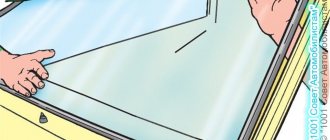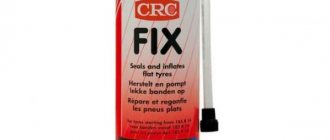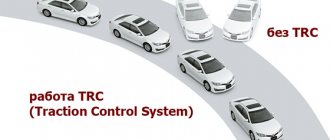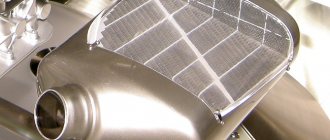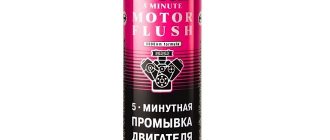The fragility of the material and the location of the headlights make the optics one of the most vulnerable systems of a car. To replace glass and insulate joints, car enthusiasts recommend using high-quality sealing compounds based on silicone, polyurethane, butyl and other materials.
Headlight sealants are available in the form of liquid adhesives and tapes that have a wide operating temperature range, good adhesion and moisture resistance.
Main types of sealants
The consistency and properties of sealing substances depend on the material and technological additives.
Silicone
Silicone sealants are used for gluing front and rear optical devices, car windows, sunroofs and other external parts. The adhesive has good adhesion, resistance to vibration and heat, but is vulnerable to the action of technical fluids - gasoline, antifreeze, antifreeze, oils, etc. They corrode the attaching layer, reducing its elasticity and mechanical strength.
The silicone-based product can be applied to both the metal body of the optics and the plastic one.
It is not suitable for strengthening the pan and other parts in contact with aggressive liquids.
Polyurethane
Polyurethane products, unlike silicone ones, do not swell or crack under the influence of aggressive substances. In addition to petrochemicals, the material is resistant to mold, weak acids and alkalis. The liquid composition evenly fills cracks and surface damage, eliminating the penetration of dirt and water into the headlight. An additional advantage of polyurethane sealants is the absence of shrinkage after gluing, and the disadvantages are reduced elasticity and vibration resistance.
The glue retains its strength for 5-8 years (some types up to 20-25 years), so it is actively used by both car enthusiasts and professional craftsmen.
Anaerobic
The reaction of anaerobic agents begins not upon contact with oxygen, but upon mechanical action (compression). This allows the substance to be distributed over the surface without time restrictions. When applying glue, the master can take his time and get a thinner and more uniform layer than when working with aerobic compounds.
Oxygen-free sealants are resistant to vibration, heat, fuel, aggressive petrochemicals, acids and alkalis.
To glue the glass, you need to bring it to the headlight body, pre-treated with glue, and press firmly.
Heat resistant
Sealants that can withstand high temperatures are sold in the form of 2 components - a powder and a solvent. Before starting work, they need to be combined and mixed thoroughly.
They are designed to work with halogen lamps, which heat up to +180°С…+300°С. Heating standard silicone and polyurethane adhesives to such temperatures can reduce the service life of glass to 4-6 months.
Heat-resistant mixtures work up to +350°С…+400°С, and tolerate contact with gasoline, antifreeze and other chemicals well. It takes 8-12 hours for the layer to harden.
Butyl
Butyl automotive sealants are available in the form of thick tapes. During operation, they are distributed over the surface of the headlight, and glass is placed on top. The adhesive is resistant to high temperatures, vibration, gasoline, oil and technical fluids. The service life of the layer is at least 7-10 years.
Unlike liquid compositions, bitumen tapes do not emit harmful volatile substances, therefore, when working with them, special means for protecting the eyes and respiratory tract are not required. The material is easy to work with and does not stick to hands or clothes.
The required layer thickness is obtained by stretching the material, so gluing does not require a special gun or high accuracy in extrusion.
Main varieties
Modern auto sealants have a polymer base with the inclusion of hardeners and fillers, which allow the substances to reliably glue fragments into a single whole without disturbing the optical characteristics of the products. The consistency of sealants is liquid or paste depending on the component composition. Sealant for headlights is packaged in tubes, bottles, jars, cylinders, rolls. For convenient application of glue, the packaging is equipped with a conical spout - a removable dispenser.
To prevent the light from scattering and deteriorating the quality of lighting, the glass is glued to the base of the headlights using sealants, the range of which is quite diverse on the automotive market. It is most convenient to use ready-made one-component substances for quick sealing of car headlights. All sealants are classified into four broad groups.
Silicone
The density, viscosity and elasticity of silicone material are the main advantages characteristic of silicone adhesives. The materials include rubber of fluorosiloxane, siloxane, and organosilicon origin. Special additives and atmospheric moisture give the substances high elasticity. Features of silicone sealants for headlight glasses:
- They have qualities characteristic of elastic and elastic rubber.
- Used to seal seams and cracks 5-6 mm deep.
- Provides even coverage of the treated surface.
- Maintain technical characteristics at temperatures up to +250°C.
- Disadvantage - they are susceptible to the aggressive effects of fuels and lubricants, antifreeze, and oils.
Resistance to high temperatures is an added benefit of using silicone for headlights, as some halogen bulbs get very hot. Silicone-based substances effectively replace damaged or worn elastic gaskets. The area of use of sealants is glass, windows, lanterns, hatches.
Polyurethane
Among the entire range of gluing compounds, polyurethane compounds are the most popular. This is due to the versatility of using sealants - they are suitable for gluing headlights, body parts made of glass, plastic and metal. Polyurethane compounds are characterized by high adhesion to different types of surfaces. Sealants have good waterproof properties and do not allow air to pass through. Other benefits of polyurethane sealant for car headlights:
- Wide operating temperature range – -60+80C°.
- Possibility of use in any climatic conditions.
- Resistance to aggressive environments - fuels and lubricants, acids, alkalis.
- Reliability of the sealed layer, moisture and air tightness.
- Elasticity, uniform processing of geometrically complex shapes.
Related article: Sealant for aquariums - requirements, choice, best manufacturers
Gluing headlights with polyurethane sealant allows you to obtain a uniform layer on the surface being treated, which has spring properties under mechanical stress and deformation. After application, the material does not shrink, so re-processing is not necessary. Most service stations use polyurethane sealants for gluing headlight glasses. An insignificant disadvantage of sealants is the inclusion of toxic components in the composition, which requires the use of personal protective equipment when sealing.
Anaerobic
A separate category of materials for the restoration of car headlights is anaerobic sealants. The main advantage of the compositions is high plasticity. Substances remain elastic for a long time when exposed to air and begin to quickly harden in the absence of oxygen. Anaerobic type sealant can be used as a gasket layer, suitable for sealing flange joints, but is most often used for restoring headlights. Key features of the compositions:
- Good resistance to aggressive influences.
- Easily withstands high temperatures -90+175ºС.
- It has a liquid consistency that hardens with air.
- After complete polymerization, it does not shrink.
- It is absolutely safe for cars.
When using anaerobic sealants, there is no need to squeeze or press the surfaces to be joined. The glue reliably fixes the fragments, and the remaining liquid mass is easy to remove from the treated coating with a conventional tool. A long drying time in air helps to form uniform adhesive seams.
Heat resistant
Some lamps used in car optics heat up the surface very much. To glue fragments exposed to high temperatures, it is necessary to use special sealants with pronounced heat-resistant properties. Such adhesives can withstand temperatures up to +375C°. The applied sealed layer is not destroyed, its integrity is not compromised by vibration and deformation loads. In simple words, if the car is thoroughly “thrown” on potholes, the headlights glued together with heat-resistant sealant will not crumble.
Paste and solid heat-resistant adhesives are two-component compositions. They are characterized by an extended operating temperature range and high resistance to extreme loads. The only disadvantage of heat-resistant sealants is the long drying time.
On video: Sealant for car headlights Dow Corning 7091
Criteria for selecting sealant for headlights
The main criteria for selection are color, operating temperature range, adhesion strength, elasticity and resistance to dynamic loads (in particular, prolonged vibration). In addition to the technological characteristics, it is important to pay attention to the ease of use and removal from the surface.
Bonding level
A high-quality sealant should reliably fasten the elements of the optical system. To ensure high adhesion, when choosing a product you need to pay attention to the material (metal, plastic) and gluing conditions.
Anti-vibration properties
The movement of the car creates a dynamic load on all elements of the body. If the adhesive material is not resistant to vibration, it will quickly fill with microdefects, and the connection will quickly lose its tightness.
Most sealants have good resistance to mechanical loads and anti-vibration (damping) properties.
Ease of removal
Residue of adhesive should be easily removed from hands, work benches, surfaces around the seam and the body when repairing the headlight. Depending on the type of composition, a hair dryer or solvent is used for this.
Temperature resistance
High temperature resistance is important due to the heating of the optical instrument during operation. The lower limit is given to reflect the full operating range and provide resistance to temperature changes.
Average operating temperature depending on the base:
| Glue type | Operating t range, °С |
| Silicone | Up to +250 |
| Polyurethane | -60…+80 |
| Anaerobic | -80…+175 |
| Heat resistant | Up to +375 |
| Butyl (butyl rubber) | Up to +250 |
Transparency
Transparent sealant is necessary for local headlight repairs, filling microcracks and other surface defects. Black compounds and tapes are suitable for application around the perimeter of glass.
Packaging volume
Packaging volume can range from 40-50 ml to 300-500 ml. When choosing, you need to take into account the price-to-weight ratio of the product, storage time and conditions, as well as the expected consumption for the required number of headlights.
Cost and quality
Experienced car enthusiasts recommend choosing products from the middle and high price segments, because... Cheap compounds do not seal joints well and reduce the luminous flux of the headlight. The released volatile compounds settle on the glass, leading to clouding.
What kind of sealant to glue headlights to: let’s understand the types
Headlight glass adhesive helps repair damaged headlight glass. The use of this composition is due to the fact that the optical device is not allowed to pass through liquids and air. If this happens, condensation will form on the glass. This, in turn, will greatly deteriorate the quality of lighting and weaken the diffuser. In addition, such a defect will significantly spoil the appearance of the vehicle.
Today on the automotive market there is a wide range of similar products for every taste. These include liquid sealants for windshields, for replacing gaskets in the engine and other car parts. If the composition is produced in liquid format, it is equipped with special removable dispensers. Those who decide to buy headlight sealant in paste format should be prepared to dilute it with a special substance that comes with the product.
It is customary to glue optical instruments with one-component sealants, which are immediately ready for use. Adhesive sealant for headlights is available in different packaging options: you can find it both in bottles and tubes, and in the form of rolled tapes. Let's take a closer look at which sealant is best for headlights.
Professional headlight sealant by category
- Silicone sealants. With their help, you can create an elastic adhesive pad that can replace the old one. Once it hardens, the product gains flexibility comparable to that of rubber. The main advantage of this sealant is simplicity and ease of use, resistance to various temperature conditions. The disadvantages include poor tolerance to gasoline, antifreeze and oil, so silicone cannot be used when repairing a gearbox or radiator.
- Sealants for headlight glasses made of polyurethane. Such compositions are characterized by an increased level of adhesiveness and increased moisture resistance. The materials are perfect for gluing headlight lenses. Motorists and auto mechanics note the reliability of the connection and long service life. It is important that such sealants are not recommended for fixing moving auto parts.
- Anaerobic compositions differ in their properties in that they do not solidify upon contact with air. Therefore, you can not be afraid to apply them to spare parts, because hardening occurs exactly when the parts to be glued begin to come into contact with each other. Such sealants can withstand both low and very high temperatures without changing their original qualities. How long an anaerobic sealant takes to dry is indicated in the composition instructions.
- Heat-resistant sealants. Thermal sealant for headlights is characterized by increased resistance to load and vibration. Can withstand temperatures up to 375 degrees Celsius. Available in aerosol, powder or paste format. If the buyer chooses powder, it will have to be diluted first. The main disadvantage of this type of sealant is the long drying period, which takes at least ten hours.
Read more: How to install a stabilizer link
Popular headlight sealants
Orgavyl
Orgavyl is an elastic black butyl tape. It adheres well to the surface, protects the inside of the headlight from the penetration of dirt and water, and is resistant to chemicals and UV radiation. Temperature resistance: from -55°С to +100°С.
Orgavyl sealant is often used in everyday life.
Abro
ABRO WS 904 tape material is also made from isobutyl polymer and is supplied as a durable long tape. Products of this brand are most popular among car enthusiasts.
Permatex Flowable Silicone
This 1-component silicone adhesive is used to repair headlights, sunroofs, windows, convertible roofs, etc. It penetrates well into cracks and securely bonds glass to metal or plastic. Operating temperature range: -62…+232°С.
Dow Corning
Dow Corning 7091 Sealing Compound is made of silicone. It is suitable for installing headlights, gluing lamps, insulating parts of mechanisms, etc. Its advantage is high adhesion when attaching dissimilar materials (for example, glass with metal or plastic).
Operating temperatures of the product: -55…+185°С.
Done Deal
DoneDeal DD6870 belongs to the class of polyurethane sealants. In addition to the main polymer, it contains elastic substances, adhesion enhancers and other technological additives. The product is used for fastening and insulating headlights, body elements, lanterns, hatches, etc.
Drying the product takes only 15-30 minutes. Its operating temperature is -60°С…+270°С. Some car enthusiasts note clouding of the glass after gluing with this product.
Optima Premium GF-KB
Optima butyl tape features good adhesion, chemical resistance, flexibility, dimensional stability and radiation resistance. Heat and compression are required for the material to harden.
The kit is enough to repair 5-6 headlights.
3M PU 590
American adhesive 3M PU 590 is made on the basis of polyurethane. It does not tolerate temperatures above +100°C, but is resistant to mechanical stress, vibration, aggressive chemicals, moisture and ultraviolet radiation. After hardening, it reliably connects even dissimilar materials. The finished seam can be painted with automotive paint.
Emfimastic PB
The adhesive of the French brand is made on a polyurethane base with functional additives. The mastic is convenient for installation, glues dissimilar parts well, hardens quickly and does not crack after long-term use.
There is no smell or strong shrinkage of the seam when working with this sealant.
The disadvantage of the product is the need to use a manual or pneumatic gun for application.
K2 l3050
K2 l305 glue allows you to quickly repair or restore headlights made of plastic and glass. The mass fills microcracks, pores and other damage well, restoring the transparency and luminous flux of the optics.
Quixx
The Quixx repair kit consists of sealant and polishing paste. They allow you to quickly repair optics, fill microdamages on the surface, and remove yellowness and cloudiness.
Versachem Mega Gray
This sealant was developed specifically for restoring headlights and meets all the requirements of car manufacturers. After the substance hardens, the compound becomes resistant to antifreeze, vibration, moisture, diesel and gasoline, oils, UV radiation and heat.
The operating temperature range is -73°С…+340°С.
Sikalastomer-710
SikaLastomer-710 liquid sealant is made from butyl derivatives and solvent, which maintains a convenient paste consistency.
Curing of the applied product occurs through drying.
The finished connection retains its integrity for 10-15 years.
Silkam
Silkam forms a strong connection between homogeneous and dissimilar materials (glass, metal, plastic and wood). The curing reaction is initiated by exposure to air and moisture. The finished layer is resistant to UV rays and mechanical stress. The operating temperature is -30°С…+120°С.
Koito
Koito is a professional repair kit used to replace the standard sealant on Japanese cars. The required amount of product is separated with a knife and then fixed to the surface using heat.
Under the influence of heat, the substance fills defects and surface damage well.
Types of adhesives and sealants
To glue car windows, you need to use a sealant designed specifically for installation work. Such funds are divided into several types:
- Fast acting polyurethane. Used in cars equipped with airbags. They dry quickly, the fastening is flexible, but at the same time durable;
- Polyurethane one-component. A universal product that can be used not only for installation, but also for repair work;
- Silicone. They are resistant to ultraviolet radiation, do not allow moisture to pass through, and reduce vibration. Disadvantage: loss of strength after silicone is exposed to motor oil, diesel fuel, or gasoline;
- Anaerobic. Dries quickly and provides a high degree of fixation. The downside of such sealants is considered to be insignificant elasticity.
Craftsmen advise using quick-drying glue for gluing a windshield only if the car must be put into operation immediately after repair. It is better to give preference to those compositions whose polymerization occurs in 12-24 hours, since they form molecular bonds of increased strength.
In service centers, auto glass for foreign cars is glued using:
- LIQUI MOLY;
- Betaseal;
- Terostat 8599 HMLC Set, 450434;
- 501 FC Kit Dinitrol;
- ABRO WS-904R;
- Teroson Terostat 8597 HMLC;
- Liqui Moly Liquifast 1402.
When choosing glue, you need to pay attention to the presence of a certificate and the reputation of the manufacturer. The speed of hardening and the need to use additional materials during installation are also important.
Our addresses
- Auto glass on Ryabinovaya
, Moscow, st. Ryabinovaya, 65 District: Ochakovo-Matveevskoe (JSC) daily from 09:00 to 19:00 8 985 714-70-01 - Auto glass on Dybenko
, Moscow, st. Dybenko, 7/1 District: Khovrino (SAO) daily from 09:00 to 19:00 8 495 664-68-01 - Auto glass on Silikatny
Moscow, 3rd Silikatny proezd, 8 District: Khoroshevo-Mnevniki (SZAO) daily from 09:00 to 19:00 8 495 664-68-01 - Auto glass on Osennyaya
, Moscow, st. Osennyaya, 35 c3 District: Krylatskoye (ZAO) daily from 09:00 to 19:00 8 985 714-70-01 - Auto glass on Vasily Petushkov
Moscow, st. Vasily Petushkova, 3 District: Yuzhnoye Tushino (SZAO) daily from 09:00 to 19:00 8 495 664-68-01 - Auto glass on Dmitrovsky
Moscow, Dmitrovskoe highway, 110 B District: Dmitrovsky (SAO) daily from 09:00 to 19:00 8 985 714-70-01 - Auto glass on Leningradka
Moscow, Leningradsky Prospekt, 37 c6 District: Begovoi (SAO) daily from 09:00 to 19:00 8 495 664-68-01 - Auto glass on Skolkovsky
Moscow, Skolkovskoe highway, no. 33 b1 District: Mozhaisky (ZAO) daily from 09:00 to 19:00 8 985 714-70-01 - Auto glass on Leninsky
Moscow, Leninsky Prospekt, 127 bldg. District: Teply Stan (South-Western Administrative District) daily from 09:00 to 19:00 8 495 664-68-01 - Auto glass on Anokhina
Moscow, Akademika Anokhina, 2 k9 District: Troparevo-Nikulino (ZAO) daily from 09:00 to 19:00 8 985 714-70-01 - Auto glass on Mnevniki
Moscow, Nizhnie Mnevniki, 13a District: Khoroshevo-Mnevniki (SZAO) daily from 09:00 to 19:00 8 985 714-70-01 - Auto glass on Lipetskaya
, Moscow, st. Lipetskaya, 27 District: Biryulyovo Vostochnoye (Southern Administrative District) daily from 09:00 to 19:00 8 495 664-68-01 - Auto glass on Orekhovoy
Moscow, Orekhovy passage, 11 District: Zyablikovo (Southern Administrative Okrug) daily from 09:00 to 19:00 8 495 664-68-01 - Auto glass on Belomorskaya
Moscow, Belomorskaya st., 40 building 2 District: Khovrino (SAO) daily from 09:00 to 19:00 8 495 664-68-01
Instructions for use
How to install glass on sealant:
- clean off the remains of the old layer;
- degrease the surface, prime it if there is a preparatory liquid (primer) included in the kit;
- distribute liquid glue using a gun or dispenser (for tape materials - cut off a piece of the roll, heat it, stretch it and place it in a special groove);
- assemble the headlight (press down the adhesive layer with glass);
- squeeze or hold for the specified time until hardened.
Why do you need sealant?
The vehicle is designed to tightly adhere the headlight parts to each other. Thanks to high-quality material, moisture and air will not be able to seep into the interior of the optical device.
Violation of the seal leads to the formation of condensation, which reduces the quality of lighting, corrodes the lens and disrupts the external aesthetics of the car.
See also:
How to seal a headlight on a car
Methods for removing headlight sealant
The layer of old adhesive can be removed thermally, mechanically or chemically.
Using a hair dryer
The air flow from a hair dryer heats the body and softens the adhesive layer. The only disadvantage of the thermal method is damage to the plastic parts of the headlight, which cannot withstand high temperatures.
Using a knife or screwdriver
The easiest way to remove excess glue from the surface is to scratch it with a knife or other sharp tool. However, it is better not to use this method for optics and parts that have an aesthetic function: when removing a dense layer of sealant, there is a high probability of damaging the headlight.
Use of solvent
The solvent can be used both to remove glue residues after heating and scraping, and to soften the entire layer without preliminary procedures.
In most cases, a special automotive solvent or acetone is used to prepare the surface.
The liquid is applied to the surface of the headlight housing for 5-15 minutes, and then removed along with the old sealing layer.
Using a body degreaser
Body or contact degreasers loosen and soften the sealant, making it easy to remove with mild tools and a rag.
White spirit, solvent, nefras
White spirit, solvent and other common solvents are also suitable for removing old adhesive residue and preparing the surface.
Using alcohol
Using alcohol, you can clean the surface from the remnants of a fragile polymer layer that has been preheated or scratched with a knife. It is better to moisten high-strength sealants with a solvent, and use alcohol only to degrease headlights that have been cleaned previously but have been left unused until repaired.
Which sealant to choose for car headlights?
Often, car enthusiasts, regardless of the brand of car, repair or replace headlights.
Sometimes they crack due to crushed stone from the car in front, sometimes they completely fall apart into two or three parts. To reassemble the headlight to its previous state, you will need automotive sealant. However, do not rush to run to the store and buy the first sealant you come across. You need to know and understand which one is best for you, what properties it should have in order to properly glue two pieces of glass (plastic) to each other.
Mistakes when choosing and using sealants
The main mistakes when using sealants include:
- incorrect choice of composition in terms of transparency or temperature resistance;
- application to an unprepared surface;
- failure to comply with the recommended drying time;
- insufficient compression force when using anaerobic glue;
- the layer thickness is too large due to rapid solidification of the liquid;
- applying a new layer of sealant over the old one, especially when combining products with different bases.
To avoid mistakes, you need to take into account the duration and conditions of glue hardening, surface preparation rules and reviews from experienced car enthusiasts about working with the selected substance.
Types of sealants
There is a huge selection on store windows. By chemical composition there are the following groups:
- Anaerobic. The hardening process takes place without oxygen. Eliminate irregularities up to 0.5 mm. In the presence of oxygen, they retain a liquid form. Used only by professionals.
- Synthetic. Contains artificial resins. Fiberglass bodies are glued together.
- Silicone. They have significant strength, elasticity, and provide tightness under high pressure. It hardens in air and takes up to 10 minutes to obtain a gasket. Eliminates unevenness up to 0.6 cm.
- Ceramic. Designed to repair the exhaust and exhaust gas systems if the damage is minor and detected at an early stage.
- Polyurethane. Glue various surfaces. They have high adhesion. They have a range of colors for repairs.
- Temperature. Withstands heat up to 3500 degrees.
- Not hardening. The composition contains rubber and synthetic resins, dries slowly and remains soft after the alcohol evaporates. It is used for filling voids, automobile bodies, and sealing metal structures. Resistant to water, oils, gasoline, and can withstand high temperatures.
According to their intended purpose, sealants are divided into:
- Sealants for car windows and headlights.
- Used for exhaust system. An indispensable thing here is a heat-resistant automotive sealant - a gasket. Pastes, adhesives and cements are suitable for repairing rounded shapes.
- Thread liquid adhesives. They secure connections, preventing components from coming loose. Anaerobic fixatives are ideal.
- For radiators. Fix leaks temporarily if there is no car service nearby. Most products are made from natural organic matter and come in powder form. Another type, made of metallized polymers, eliminates leaks with a diameter of up to 1 mm.
- For the body. Here there is a division into the following varieties:
- Suture (in a tube). The most common and used automotive sealant with polyurethane for body work and seam treatment. A gun is required for application.
- Suture (under the brush). Available in cans, it has a one-component composition. Fills butts, welds and glues metal elements.
- Sealing tape. No drying is needed and you can paint it.
- Sealant in a tube. Perfect for small jobs, available in different colors.
- For car wheels. Designed for tires, it can be repair and preventive. The repair one is applied after a puncture. Preventative is poured into the tire during its installation.
How long does it take for car sealant to dry? It depends on the composition and ingredients. Silicone quick-drying sealant forms a film within fifteen minutes, complete hardening occurs in 24 hours, and strength gain will increase up to 5-7 days. But in general, all information is usually indicated by the manufacturer in the instructions on the packaging and cases are individual.
So let's move on to our review.
